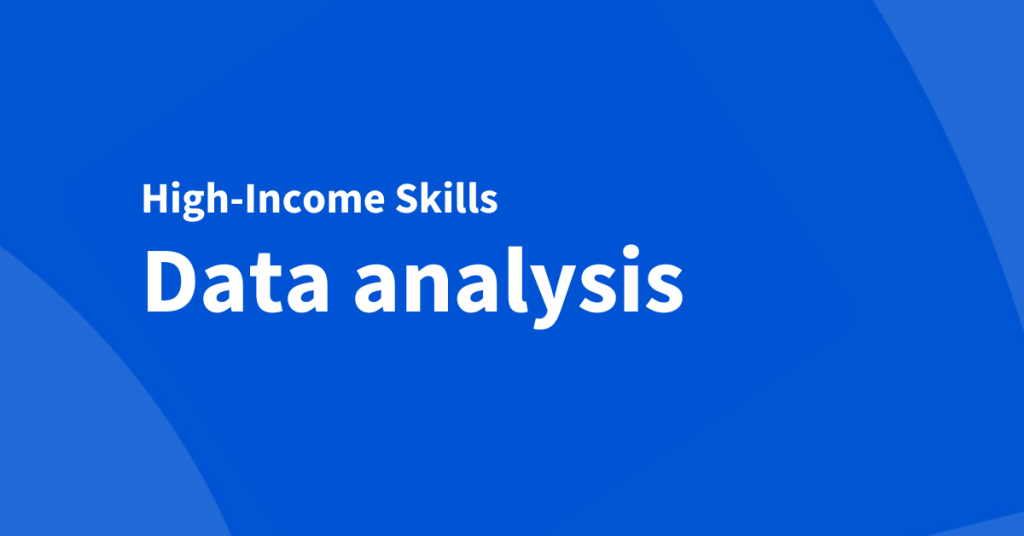Data analysis: where to start and how to build this high-income skill


Hello!
We are really excited to share this next series with you, in large part because we saw your excitement with our previous issue on job skills, and because understanding how to curate an impressive portfolio of job skills is one of the most important aspects of driving your career development.
Over the next several issues, we are going to be discussing high-income skills.
High-income skills are skills that tend to be associated with high-paying roles and are in high demand among employers. These skills also tend to be valuable across industries and can be used productively across a wide range of job functions.
We developed our list of high-income skills by combing several job skills studies (from organizations including the World Economic Forum, Pearson, Future Learn, Coursera, and others) and identifying the skills that came up most frequently.
This week, we’re going to talk about data analysis skills.
Data analysis skills are not only valuable for data analysts. Even basic data analysis skills can enhance your daily workflow. Whether you realize it or not, you are receiving and interpreting data all the time. The first lecture video in Google’s Data Analytics Professional Certificate explains this really nicely. (We recommend watching the entire video, but if you’re pressed for time, skip to the 1:45 mark to learn how data may show up in your daily life.)
With strong data analysis skills, you can be more intentional with the data you receive, the way you interpret it, and the way you share it. Here are three examples of how data analysis skills may show up in your career, job search, or even personal life:
1. Data analysis for highlighting accomplishments on your resume
Supporting your resume bullet points with data can be an effective way to demonstrate your accomplishments to potential employers. Let’s examine how we can use data analysis to improve the following resume point:
“Successfully launched an advertising campaign that increased website traffic.”
To measure the success of your ad, you might start by recording the average number of website visitors before it was launched. Next, you could collect the average number of website visitors after it was launched. By calculating the percent of increase, you’ll have a compelling statistic to enhance your point:
“Launched an advertising campaign that increased website traffic by 103%.”
2. Data visualization for effective idea pitching
Numbers can help your audience paint a mental picture. At times, an actual picture can be even better. Data visualization skills enable you to represent information in a visually appealing, easily digestible way.
Using the example above, you might translate your last ad campaign’s 103% increase in website traffic into a line graph with a steep, eye-catching incline. To pitch an idea for a similar campaign, you might even use predictive analytics to forecast future success based on past successes.
3. Data interpretation for expert insights about anything
The ability to recognize patterns in data is a core aspect of data analysis. When you interpret data, you can use it to make data-informed decisions, which can ultimately lead you to results that are more likely to align with your desired outcomes. For example, interpreting data about high-income skills enabled us to develop this list, which you can use to move toward your desired career outcomes.
Where to begin
If you’re new to data analysis, a good place to start is with the first course in the Google Data Analytics Professional Certificate, Foundations: Data, Data, Everywhere. This course is a nice introduction to data analytics, and if you enjoy it, you can continue advancing through the rest of the certificate program.
If you’d like to learn more specific data analysis skills, here are some additional recommendations:
- Excel Skills for Business Specialization from Macquarie University: Excel is a powerful tool for data analysis when you’re working with smaller, less complex data sets. Learning Excel (or Google Sheets, which is similar) is one beginner-friendly way to enhance your analysis capabilities.
- Introduction to Structured Query Language (SQL) from the University of Michigan: Learning SQL can enable you to analyze large data sets housed in databases. In general, SQL is still considered beginner-friendly, although it may feel a bit more advanced than Excel.
- Data Analysis and Visualization Foundations Specialization from IBM: Learning data visualization can enable you to effectively share your analyses with others, thus opening up the opportunity for you to use your analytical skills to influence high-level decision-making.
That’s all for this week. Next week, we’ll discuss another high-income skill, project management. Until then, let us know how data analysis skills can enhance your workflow in the comments.


